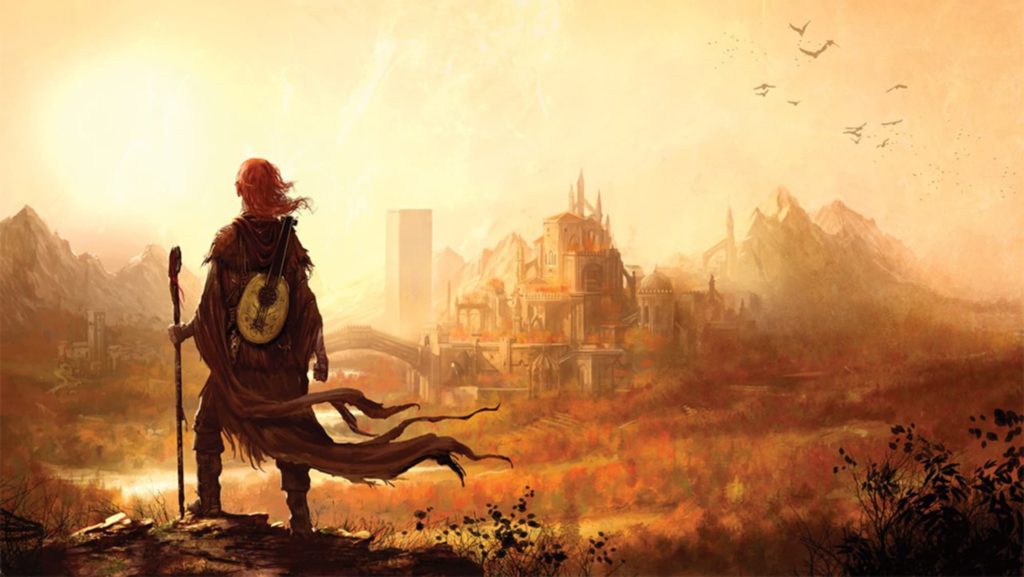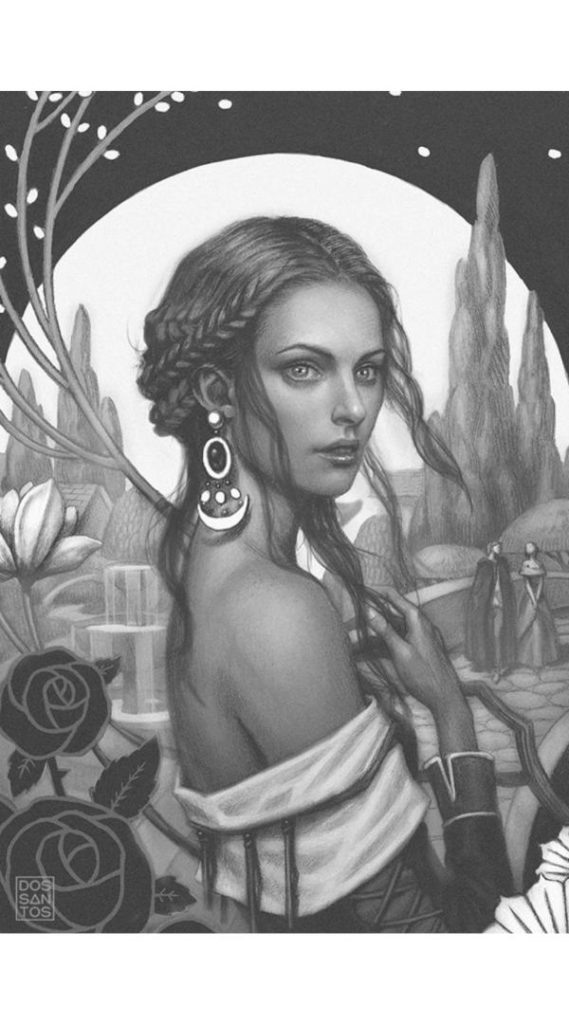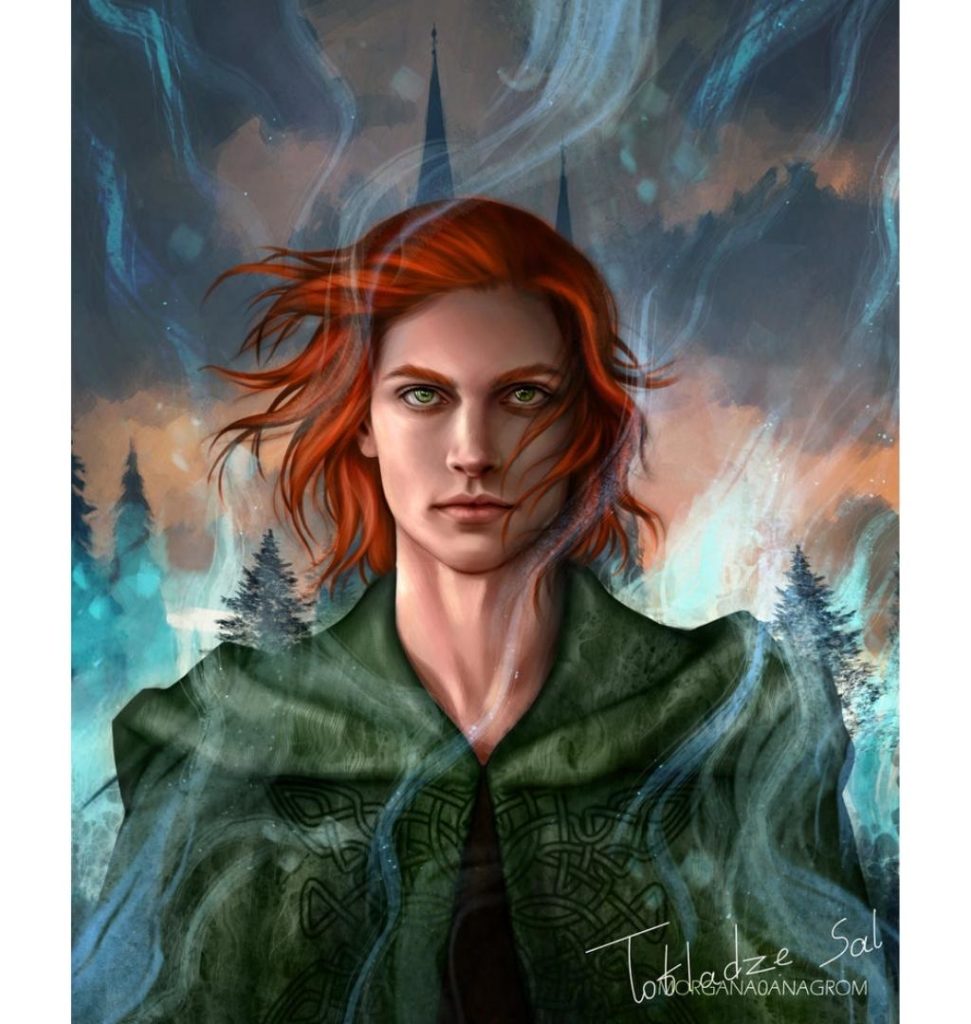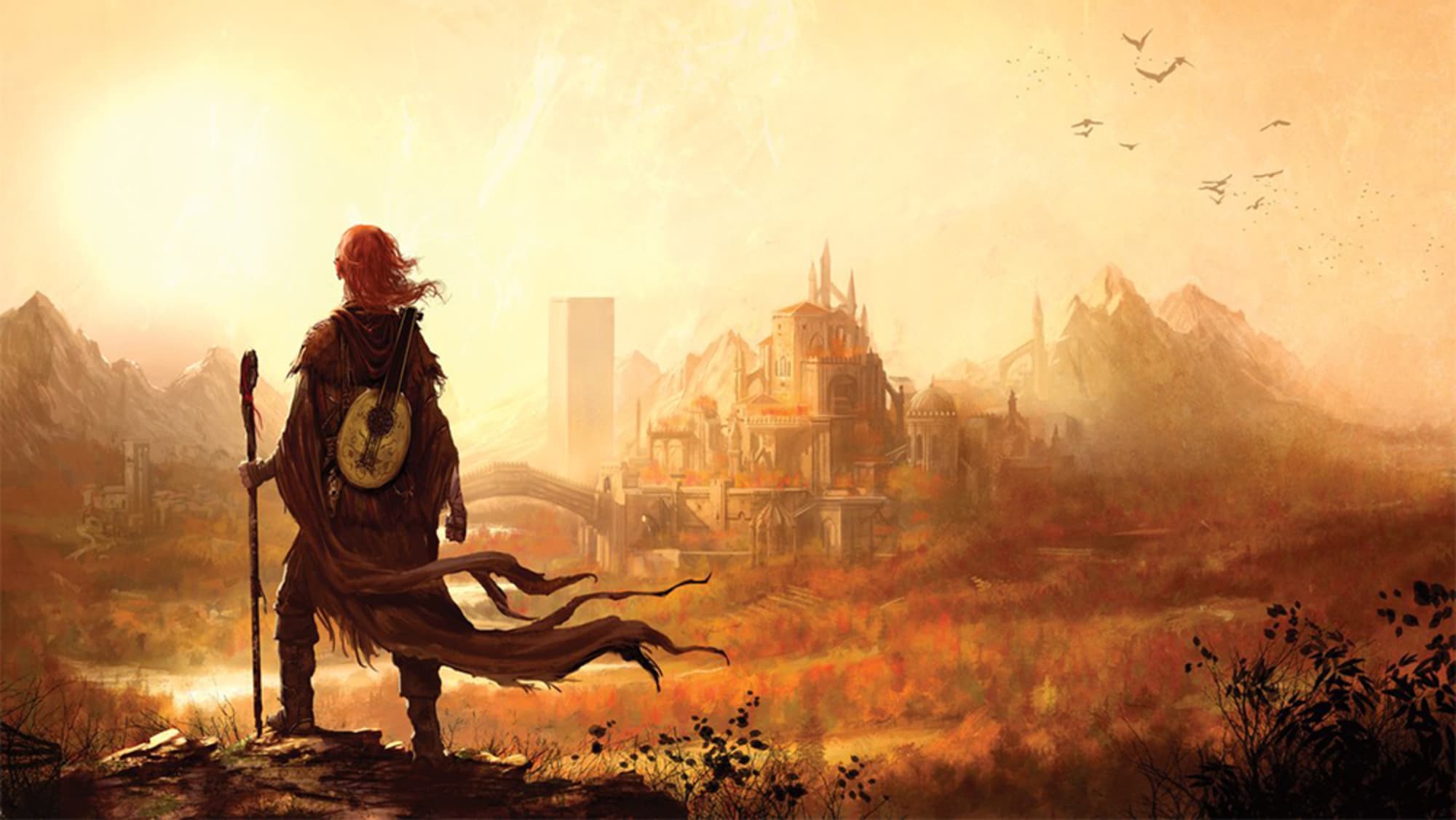ThE NAME OF THE WIND BY PATRICK ROTHFUSS – REVIEW
By: Preston Simmons | Written: 12 July 2021

The Kingkiller Chronicle book series is pretty controversial for fantasy fans. It’s beloved by all who read it, but at the same time, frequently appears on “do not read” lists. So, how can it be that so many people, including those who absolutely love the series, urge people not to read it? The answer is simple. The Kingkiller Chronicle series is stuck in what I call the “ASOIAF Dilemma,” or if referred to by the author, “the GRRM Dilemma.”
The ASOIAF Dilemma
The ASOIAF Dilemma is when a viral series remains incomplete for so long that interest dwindles over time to nothing. In terms of ASOIAF, the last book of the series, A Dance with Dragons, was released in 2011. Coincidentally, in the same year that the last written book was released, the first season of Game of Thrones premiered on HBO. It has now been 10 years, almost to the day (July 11, 2011) that A Dance with Dragons was released. Since then, Game of Thrones finished its run with 8 seasons, ending back in 2019. How many books in ASOIF have been written in the 10-year time gap?
Zero.
While GoT was airing, interest in the series was at an all-time high. You could not go a week without some major entertainment news source talking about the show. Tens of millions of viewers tuned in to watch the finale. Unfortunately, most fans consider it the most disappointing finale of all time. But, rejoice! George R.R Martin, the original creator of the series, could finish it as it was meant to be. There shouldn’t be any worry because the previous five books were amazing. All that was needed was for GRRM to write the next two books. A simple task for what many consider to be the greatest fantasy writer of our time.
But as we all know, when fans needed him most, he vanished. There have been no “next two books.” In fact, there hasn’t even been a “next book.” Fans are now wondering (rightfully so) if Martin will ever finish the series. Mainstream audiences have all but forgotten the series even exists. Interest for the next book has plummeted.
This is where the Kingkiller Chronicle stands today.
A Warning Before You Start Reading
Before you start reading The Kingkiller Chronicle series, I should warn you. There is a good chance Rothfuss will never finish this series. You may be left forever wondering what happens next. It could be years before Patrick Rothfuss releases the next book. Like with ASOIAF, the second book in The Kingkiller Chronicle, the Wise Man’s Fear, was released nearly 10 years ago, with no word on the release date for the next book. It is up to you as a reader whether you are willing to invest time in a series that may never finish.
With that said, if you do decide to read the series, have no fear of reading a bad book. The Kingkiller Chronicle is a masterpiece. It’s one of the best epic fantasy series I can recommend, even if it’s not fully complete. In it, you will read about characters you will love. You will find yourself transported to a world filled with magical creatures, gods and demons, and grounded heroes. You will learn the beauty of music, love, and loss. This, and more, will all be seen through the eyes of Kvothe.
Without a doubt, The Name of the Wind by Patrick Rothfuss is a must-read book for all fans of high fantasy, epic worldbuilding, and fantastic writing.
What Makes The Name of the Wind So Good?
There are a few qualities I look for in a good book. For me, the most important are well-written characters, fleshed-out world-building, and intriguing plot. One quality that is seldom mentioned but could perhaps be the most vital is readability. The Name of the Wind is one of the easiest fantasy books I have ever read. That is not to say that the book is written in a simple matter. No, if anything, Patrick Rothfuss has prose suited for more of an adult audience. It rewards careful attention, something that simple prose that is written for fifth graders lacks.
The Name of the Wind has around 722 pages, but while reading, it felt like it had only 200 pages. The story flowed so smoothly, and not a single chapter felt overly long or drawn out. This was a book that was hard to put down, but when I did, it was effortless to pick it back up and start again. It reminded me of reuniting with an old friend. Though it might have been a while since you have talked to or seen each other, once you get back together, it’s like you’ve never left one another’s side. That’s what it felt like while reading the book. I never once was lost or confused when I returned to it, even if I put it down to read a nearly 3,000-page book in between.
Without even getting into the plot, the characters, the world-building, the magic system, or the music, that’s what makes The Name of the Wind so good.
But what’s a review without at least mentioning those things?
The Story of The Name of the Wind by Patrick Rothfuss
The story of The Name of the Wind, on paper, is simple. This is the story of Kvothe, told by Kvothe to a man that goes by the name Chronicler. It’s the tale of how Kvothe, a man of a thousand names, a legend, went from being one of the most famous people in the world to be an innkeeper. What happened? Why did he disappear? How did he become known as Kingkiller? These are just some of the questions Kvothe promised to answer to Chronicler while he told his tale, one that he promised would take no more than three days.
The Name of the Wind takes place on the first day of Kvothe’s tale. Therefore, It’s a book of beginnings. It is the first part of Kvothe’s life. This is before Kvothe became a man of legend.
This book can be broken up into two distinct sections; present-day and Kvothe’s tale. The present-day sections of the books are written in 3rd person, while Kvothe’s tale (the majority of the book) is written in the first person.
Overall, I really enjoyed the story. There are clear sections of the book that represent different parts of the beginning of Kvothe’s life. To me, each section was a joy to read. They were memorable while also being unique to one another.
That said, if you are looking for a story with fast-paced action sequences, massive battles, or adventure on a vast scale, this is not that book. This book is about a boy finding a path in life. It’s a book about survival—a book about love.
The Characters of The Name of the Wind
If you have read any of my past book reviews or read my article on character-focused fantasy novels, you will have noticed how much I value well-written characters in the books I read. The characters of The Name of the Wind by Patrick Rothfuss are, unsurprisingly, very well written. Before I go on and talk about how much I enjoyed reading about Kvothe, as it is his story, I would like to talk about the side characters.
One of the most challenging aspects of writing a long fantasy novel is the number of characters that inevitably must appear in the story. Each of these characters must be unique, with their own voice; their own personality. Having a book where all the characters act and speak the same will lead the reader to be bored and feel that the world is unbelievable. This is not the case with The Name of the Wind.
In this book, all the characters feel unique from one another. Even characters that only appear for a page or two all felt different in some way. Now, what about the main characters?
Again, before I begin to speak of Kvothe, let me talk about the main cast. Though there are many different characters in the book, the main cast would consist of Denna, Bast, Chronicler, and Ambrose.
The Main Cast of The Name of the Wind by Patrick ROthfuss

Who is Denna:
Denna is probably the most fleshed out yet mysterious of our main characters. She’s independent, witty, clever, and in some ways, tragic. Of the group, she is probably the most interesting main character in the book. She’s the main love interest of Kvothe and the most beautiful described character in the story. Not just physically but emotionally. Reading about Kvothe trying to understand her as a person and falling in love with her, while at the same time barely knowing a thing about her, was wonderful.
Bast, the apprentice:
Bast, Kvothe’s apprentice in the present day, is also incredibly interesting for reasons I can’t explain without going into spoilers. Needless to say, every character has layers to them that you may not expect at first glance.
Chronicler, the scribe:
Chronicler, the scribe that Kvothe recants his tale to, is the only other POV character we have in the book besides Kvothe. At first, I liked Chronicler. I liked his quick-mindedness, charm, and ability to talk his way out of dangerous situations. Surprisingly, by the end of the book, my opinion of him changed. If anything, I started to dislike him. This is not a negative thing. It was great character development. While Chronicler was all those things I mentioned, he also proved himself to be judgemental and naive.
Ambrose, the antagonist:
Ambrose would be who I would consider the antagonist of the book. In my opinion, the best antagonists are those who are relatable. They are the ones where you can see their side of things. You can understand why they do the things they do. Oftentimes, a good antagonist can be the best character in the entire book. Ambrose is not that kind of antagonist. No, he’s more in the realm of Joffrey from ASOIF. In fact, I wouldn’t be surprised if Rothfuss took inspiration from Joffrey to create Ambrose. He’s spoiled, rude, arrogant, with hardly a redeemable quality to him that can make you see his side of things. His “battles” with Kvothe are also some of the most fun chapters in the entire book.
Who Is Kvothe?

In my review for On the Shoulders of Titans by Andrew Rowe, I talked about how difficult it is to write a book in the first person. The Name of the Wind by Patrick Rothfuss is a book written in part first-person and part third person. Kvothe, our protagonist, is who the majority of the book follows. In the book, he tells the true tale of “Kvothe Kingkiller” to Chronicler, so it’s through his eyes that most of the book takes place.
Kvothe, simply put, is one of my favorite protagonists I’ve read in recent memory. He’s a hard worker, smart, talented, kind, and a genius musician. Yet, he’s not a mary sue. He’s flawed in as many ways as he is gifted. He’s outspoken to a detrimental degree. He often acts before he thinks, he’s prone to major jealousy, and he’s quick to get into unnecessary fights. All of this and more make him a fascinating character to read about.
Another wonderful decision on Rothfuss’ part is having the third person present-day chapters of the book follow someone else other than Kvothe. Kvothe the innkeeper is vastly different from Kvothe the boy or Kvothe the musician. Kvothe, the innkeeper, is depressed, quiet, humble, and more than anything, he wants to be unseen. Knowing that eventually Kvothe, the innkeeper is who he will become makes reading about who he was much more interesting.
At the end of the day, The Name of the Wind is Kvothe’s story. It only fits that a book this good would have such a compelling protagonist. As I’ve said before, a book is only as good as the characters within, and Kvothe is one of the best.
Final Thoughts
Overall, The Kingkiller Chronicle is an amazing book. The readability, the characters, the prose, the worldbuilding, the music all amounted to one of my favorite reading experiences in recent memory. Though Rothfuss may not ever finish the full Kingkiller Chronicle series, the first book, The Name of the Wind, is a must-read for all fantasy fans.

The Name of the Wind by Patrick Rothfuss
10
Masterpiece

Pingback: Best Epic Fantasy Series For Beginners | Reader's Grotto
I’m slogging through the first book. I like the story, but the main character is a lie-cheat-and-steal kind of kid. His conscience is untroubled. He steals when he doesn’t need to though he is impoverished and may see no other way to get by sometimes. He lies and cheats his way into university. He maliciously attacks an obnoxious professor. When does the main character become likeable or if not likeable, admirable?